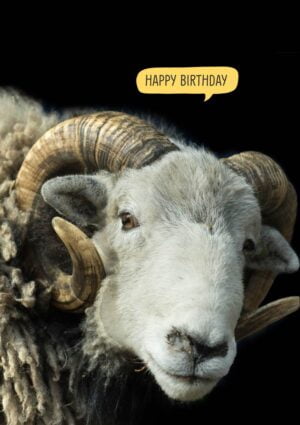Preserving the Herdwick breed with Beatrix Potter to the rescue. This is one of those stories that show what talent and determination can do.
This little guy with the curly horns is a Herdwick ram. He happens to be saying Happy Birthday, but there is more to his story than a birthday card, appealing though it is.
This is the story about preserving the Herdwick breed.
Herdwicks are upland sheep. They all belong to and have there own heef, an area of unfenced land where they and their parents and their ancestors were born and lived.
Hefted To The Hill
They roam freely over their heef and even if they are transported miles away, they will work their way back. As upland sheep farmers would say, they are hefted to the hill.
This is important because there is no way that vast tracts of upland could be fenced. So sheep that stay were they are and don’t stray, are a definite plus.
Yet, while Herdwicks are lovely to look at, they have coarse wool and are slow growing. And they give birth to fewer lambs than lowland sheep. All in all, if economics was the only criterion, Herdwicks would not top the list of desirable sheep.
So the Herdwick was undesirable – at least that was the view of sheep breeders in the early 1900s – and the breed was slowly dying out.
Beatrix Potter didn’t see it that way. To her, Herdwicks were beautiful. And it is because of what she more than anyone did that they were saved from extinction. She is the reason that preserving the Herdwick breed has been successful.
Of course, Beatrix Potter was not just a world-famous illustrator. She was also a woman. It’s easy enough to write a sentence like that, but it echoes with meaning that was relevant as much then as it is relevant today.
She Studied Symbiosis In Lichens
She wanted to be a botanist. And it wasn’t an idle wish or a passing fancy. She studied nature and she was the first to propose that lichens are not one life form but a symbiosis between two different organisms – a fungus and an algae. The fungus brings in the food and the algae photosynthesises it.
She was an exceptional illustrator and she used her skill in observation when she conducted experiments in her kitchen. Furthermore, she was an exceptional botanist when women weren’t allowed to be anything in the sciences. Moreover, she was an exceptional scientist when women were not allowed to do anything other than stay at home.
After years of observation and experiment, she was ready to present her paper to the Linnean Society of London. Except, she wasn’t allowed to present it or even attend the meetings because she was a woman. A botanist at Kew Gardens presented her paper Germination of the spores of the Agaricineae for her.
Peter Rabbit, Mrs. Tiggy-Winkle And More
The loss to science was the world’s gain. All those characters – Peter Rabbit, Mrs. Tiggy-Winkle the hedgehog, Mr. Jeremy Fisher the frog, Simpkin the cat, Jemima Puddle-duck, the mice Tom Thumb and Hunca Munca, Squirrel Nutkin, Ptolemy the tortoise, the guinea pig Tuppenny – all of them live on in the imaginations of generations right down to today.
Those stories made her not only famous, but rich. And wth the money she earned she bought farms. She bought farms in the Lake District to preserve them from irresponsible development.
She and her friends in the National Trust bought farms side by side to lessen the risk of development. By the time of her death in 1943 she owned several farms – more than 4,000 acres (1,600 hectares) – in the Lake District. And she dedicated it to the National Trust on the death of her husband, who died in 1945.
Then, in 1951 the UK Government dedicated 885 square miles (2,230 square kilometres) as the The Lake District National Park.
A victory for the environment in the spirit of the time.
Beatrix Potter Bought Troutbeck Park Farm
One of the farms that Beatrix Potter bought was Troutbeck Park Farm. On it she built up a flock of over 1,000 Herdwick sheep. She did it partly with the aim of preserving the Herdwick breed. Herdwicks are are indigenous to the Lakeland fells with a history going back hundreds of years. And Beatrix Potter wanted that story and that history to continue.
She was well aware of the opinion of famers that Herdwicks were a less-than-desirable breed.
So, following her death she attached a condition to her gift. The farms must continue and preserve the Herdwick breed.
Fast forward to 2001, when foot-and-mouth disease struck in England. Flocks were killed and their carcasses burned to halt the spread of the virus. Because there simply weren’t the numbers compared to some other breeds, this event strained the viability of the Herdwick as a breed.
The breed survived, but had Beatrix Potter not made it a condition that the breed was supported, there may well not be any Herdwicks today.
You can buy this Herdwick Greeting Card featuring the ram in the photo at the top of this article. Just follow the link.
